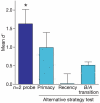Recursive syntactic pattern learning by songbirds
- PMID: 16641998
- PMCID: PMC2653278
- DOI: 10.1038/nature04675
Recursive syntactic pattern learning by songbirds
Abstract
Humans regularly produce new utterances that are understood by other members of the same language community. Linguistic theories account for this ability through the use of syntactic rules (or generative grammars) that describe the acceptable structure of utterances. The recursive, hierarchical embedding of language units (for example, words or phrases within shorter sentences) that is part of the ability to construct new utterances minimally requires a 'context-free' grammar that is more complex than the 'finite-state' grammars thought sufficient to specify the structure of all non-human communication signals. Recent hypotheses make the central claim that the capacity for syntactic recursion forms the computational core of a uniquely human language faculty. Here we show that European starlings (Sturnus vulgaris) accurately recognize acoustic patterns defined by a recursive, self-embedding, context-free grammar. They are also able to classify new patterns defined by the grammar and reliably exclude agrammatical patterns. Thus, the capacity to classify sequences from recursive, centre-embedded grammars is not uniquely human. This finding opens a new range of complex syntactic processing mechanisms to physiological investigation.
Figures




Comment in
-
Language: startling starlings.Nature. 2006 Apr 27;440(7088):1117-8. doi: 10.1038/4401117a. Nature. 2006. PMID: 16641976 No abstract available.
References
-
- Hockett CF. The origin of speech. Sci. Am. 1960;203:89–96. - PubMed
-
- Chomsky N. Syntactic Structures. Mouton; The Hague: 1957.
-
- Hopcroft J, Ullman J. Introduction to Automata Theory, Languages, and Computation. Addison-Wesley; Reading, Massachusetts: 1979.
-
- Hauser MD, Chomsky N, Fitch WT. The faculty of language: what is it, who has it, and how did it evolve? Science. 2002;298:1569–1579. - PubMed
-
- Fitch WT, Hauser MD, Chomsky N. The evolution of the language faculty: clarifications and implications. Cognition. 2005;97:179–210. - PubMed
Publication types
MeSH terms
Grants and funding
LinkOut - more resources
Full Text Sources
Other Literature Sources

